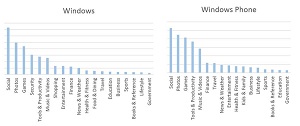News
Struggling in Mobile, Microsoft Offers Dev Tips, Mulls Android Embrace
- By David Ramel
- January 5, 2015
Microsoft, still struggling as a distant No. 3 in the mobile app OS wars, provided statistics about its Windows Phone Store app downloads and offered tips to developers to maximize success.
One tip included in its December 2014 report: Go low. Memory-wise, that is.
"With 71 percent of downloads now coming from low-memory devices, you can more than double your potential market by optimizing your app to run on low memory devices," Microsoft's Bernardo Zamora said in a blog post. "If that's not possible, consider creating a version with lower memory requirements to offer alongside your primary apps."
The app stats and dev tips were released amid media speculation that Microsoft is mulling several strategies to close the app gap between its Windows Phone platform and runaway leaders Apple (iOS) and Google (Android), including allowing the running of Android apps on the Microsoft OS. "Apparently, Microsoft is looking into Android apps on WP," reported The Verge, mentioning a Tweet by Tom Warren that said, "once Windows Mobile is released and eventually supports Android apps then the fate of WP will become clear." Rumors of allowing Android apps to run on Windows were also reported by ZDNet.
According to Statista.com, Google Play features about 1.3 million apps, while the Apple App Store has about 1.2 million. Windows Phone is a distant third with about 300,000 apps.
 [Click on image for larger view.]
Index of average number of downloads per app, in each category – Worldwide, November 2014
[Click on image for larger view.]
Index of average number of downloads per app, in each category – Worldwide, November 2014
(source: Microsoft)
To help Windows Phone developers play catch-up, Zamora's blog contains much information about trends on the Windows Phone store and many tips on how to capitalize on that data, such as targeting low-memory devices. A low-memory device running Windows Phone 7.x is 256 MB or less of RAM, while on 8.x devices it's 512 MB or less. "Low-memory devices account for the top five devices based on total downloads, and seven of the top 10." he said. The most common single device is the Lumia 520, which garnered more than 25 percent of all app downloads.
Zamora noted that Windows Phone 8.1 now accounts for the vast majority -- at about 92 percent -- of Windows Store downloads and touted the benefits of writing for that OS, such as targeting "universal Windows apps" for mobile or desktop platforms.
"Windows and Windows Phone 8.1 provide the benefit of increased functionality for customers, and universal Windows apps for developers," Zamora said. "Writing your app for 8.1 on any device allows you to easily convert to a universal project and manage one set of source code to target both Windows and Windows Phone."
Games accounted for the most downloads for Windows and Windows Phone, followed by Tools and Productivity, and Music and Videos.
Zamora also provided information on incremental downloads, or the ratio of downloads per app. "This is a function of total downloads versus total available apps in that category," he said. "For example, while Games is the most-downloaded category, Social has more downloads per available app."
"Social is currently the No. 1 category in both stores, with Photos, Games, and Tools and Productivity in the top five for both stores, a trend that has been steady for the past six months," Zamora said. "If your goal is to reach the maximum number of downloads possible, analyze these categories to understand which present the highest potential for your apps."
About the Author
David Ramel is an editor and writer at Converge 360.